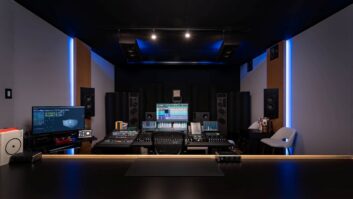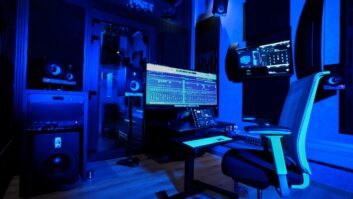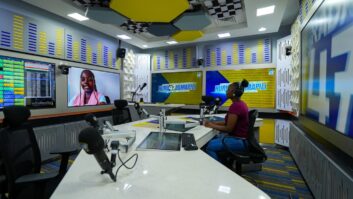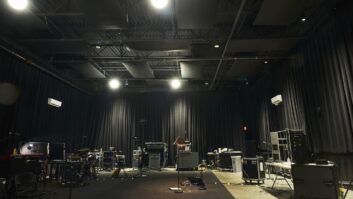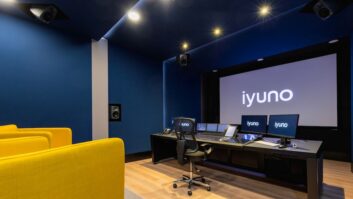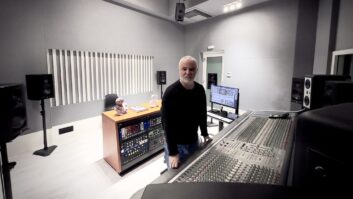
When the stock market took a nosedive back in the late ’80s, theadvertising industry felt the shock. Big-ticket clients suddenly drewin the purse strings, and agencies scurried around trying to find waysto cut costs.
This was just about the time that MIDI was coming into full stride,and project studios began cherry-picking jobs that had previously beenthe exclusive domain of the larger music houses. Eventually, many ofthese smaller studios added workstations, sync boxes, video decks andthe like, allowing them to offer audio post, sound design and originalmusic services on a one-stop-shopping basis.
In response, some of the larger advertising agencies, which hadhistorically staffed in-house music departments with music producerswhose job was to get a spot into the hands of the right composer andoversee that part of the creative process, decided that bringing musicproduction and sound design in house might result in additionalsavings. They also felt that giving copywriters and art directorsaccess to music production personnel on a daily basis would helpeliminate some of the last-minute, hit-and-miss guesswork that oftenaccompanies the creation of a jingle or score-generally the last pieceof the puzzle that gets worked on before broadcast. The big story usedto be that video houses were adding audio rooms; now the agenciesthemselves are adding audio rooms.
DDB Needham Worldwide Communications Group Inc., a major MadisonAvenue shop, now has its own variation on this theme. Cool Dry Place, awholly owned subsidiary of DDB, was founded in 1996 in order to provideclients with high-quality broadcast post-production services under oneroof, at reasonable rates.
DDB producers began turning inward in the early ’90s forpost-production on test spots-those commercials that are not intendedto be broadcast. As the in-house team began compiling a reel of work,confidence escalated. “We were slowly purchasing more editingequipment, and producers saw that we had the same gear as outsidefacilities, and that we could contain costs, work on tight deadlinesand deliver quality product,” says CDP president Geoff Smith.
Chief audio engineer Barry Rose has been with DDB for ten years, andhe cuts sound on an Avid AudioVision workstation. Dailies come into theshop on Beta SP, and Cool Dry Place editors execute a rough cut, whichRose begins working on. If the spot is for television (lots of majorradio campaigns originate at DDB, including work for Anheuser-Busch),Rose will clean up or replace dialog, sweeten the tracks with effects,and at times add some sound design work.
“With recent upgrades, we now have access to Pro Tools, and one ofour two audio rooms has a Yamaha 02R, which we really love,” Rose says.”But the AudioVision is a remarkably easy environment to record into,and I can slip sounds around to picture with no problem.” Little actualmusical composition takes place in-house-DDB still hires outside housesfor scoring and jingle work-but Rose will take snippets from CDlibraries and create effects in AudioVision by combining tracks andlayering them. Radio calls for even more inventiveness, according toSmith.
“When the visual element is not compelling-or nonexistent, such asin radio-sound design needs to bring a much more wide-open feel to theprocess, and Barry does a great job for our creatives and producers,”Smith explains, recalling a Nutrageous spot that Rose worked on for DDBNeedham client Hershey. “I used everything we had laying around here inthat spot, including a bunch of stuff I pulled off of CDs,” Roseinterjects. “I think we used the Sound Ideas, Hollywood Edge and DigiFXlibraries to help get across the writer’s idea. The concept was that ofan old radio drama, with cartoon-like sound effects used to describewhat the writer was saying-very over-the-top ways of describing thesensation of eating the bar. We used pops, whistles, punches, garbles,explosions-you name it-all edited within the Avid.”
One critical limitation of AudioVision, according to Rose, is thatit cannot access the plug-ins that add so much functionality to ProTools. “At the present time, if you want to access effects-I’d make alot of use of DINR, the Digidesign noise reduction plug-in, forexample, as well as some effects and dynamics processing plug-ins-youhave to export your session to Pro Tools. That seems like a needlessextra step to me.”
Although Avid acquired Digidesign in 1995, the two entities arestill finding their way to full integration, says Smith. “It seems thatPro Tools and Avid have yet to integrate. All indicators are that theywill be integrating the two products into single platform in 1999, andwe’re really looking forward to that day.”
Which is not to say that AudioVision, as presently constituted, doesnot offer any DSP functionality. Rose says that its internal EQ isquite acceptable for broadcast work, “and I use the reverse clip, timecompression/expansion, and pitch-change functions all the time. One ofthe things I really like about the equalization is that you can applyit per clip, without having to assign it to an entire track.”AudioVision has 16 physical inputs and outputs, with a total of 24virtual tracks within the machine. “I never run out of memory applyingeffects and EQ-we’re running a Mac 9600 computer at 300 MHz, with 128megs of RAM. All of our backups go to JAZ 1-gig disks,” Rose says.
Although Rose is a fan of the 02R’s automation package, AudioVisionoften allows him to bypass it, letting him utilize the console for itsscene memory and as a digital router, taking signals by tielines fromvideo decks, his workstation, and a variety of CD and DAT machineslocated throughout the facility. “Again, there’s a lot you can dowithin AudioVision-automate clip levels, execute fades, and applycompression and EQ,” he says. “It’s not the same level of automationthat you get with a digital board like the 02R, but you can squeeze alot out of it.”
DDB Needham is obviously the big-bear client for Cool Dry Place, butup to 40% of the facility’s business comes from outside clients,including other agencies, corporate clients and a smattering of recordlabels. Smith clearly is interested in developing outsiderelationships, though the in-house spots continue to fuel equipmentacquisition.
“Some of our recent projects include recording sessions for theJerky Boys’ new comedy CD, the 30-second TV spot ‘Night School’ forFrito-Lay, and we recently completed a project for DDB that involvedover 300 separate radio spots for Radio Bermuda,” Smith says. “Thiscontract allowed us to move up the schedule on our second audio room,especially in terms of how quickly we were able to purchase new gear.We’re looking to bring this room online in the first quarter of1999.”
